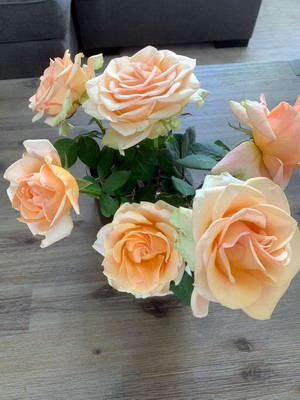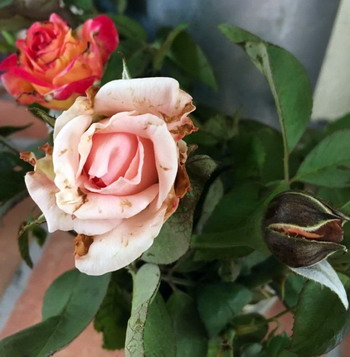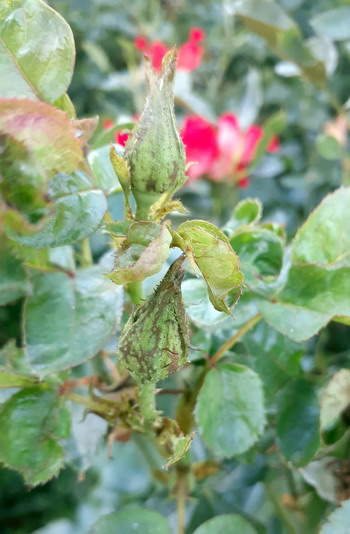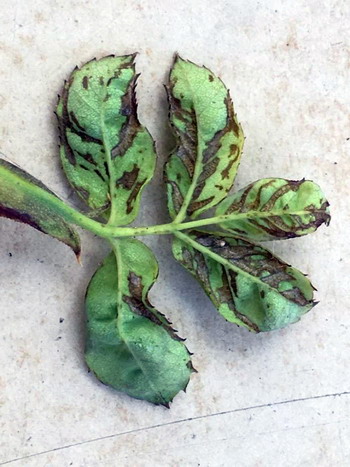Temecula Valley Rose Society Newsletter for August, 2021
Temecula Valley Rose Society
Established 1991
The Valley Rose
August 2021 Vol. 32, No. 08
the newsletter reads better in landscape mode
Tap/Click the button to read our copyright policy...
The Temecula Valley Rose Society (TVRS) respects the intellectual property of others and holds no claim to copyrights of Content that are owned by a third party or are in the public domain. All trademarks and registered trademarks, product names, logos, and brands used by the TVRS are the property of their respective owners. All company, product and service names used in this newsletter or website are for identification purposes only. Use of these names, logos, and brands does not imply endorsement.
Tap/Click to Read more
Co-President's Message, by Rebecca Weersing
July was a month to kick back, enjoy your garden during the cool of morning and evening while sipping a lemonade. Now August arrives and we can look for more of the same – more hot weather and lots of sunshine.
But August is a month when we can turn our attention to indoor Rose pleasures – reading one of thousands of rose books, watching garden videos, working on a rose puzzle and making Rose Petal tea. Maybe a Rose Book Club?
Plan needed improvements to your garden when the temperatures begin to moderate in September and October. We will be having a virtual Member Meeting this month – no need to drive but you will enjoy a great speaker. Just like July, kick back and enjoy the summer so you will be rested for all of the outdoor pleasures we will enjoy in our fall gardens.
Rose Shows are Back in Southern California: Save The Dates
by Linda Freeman
The San Diego Rose Society Click here.
Also, mark you calendars for the Orange County Rose Society show in October 23, 2021.
Desert Rose Society Rose Show; November 13, 2021: Palm Desert Community Center (more details to follow).
NEW! Birds in Rose Haven GardenGo to this page to see a month-by-month running description and photos of the birds visiting Rose Haven.
How Does Your Garden Grow, by Rebecca Weersing
Question: Why at this time of year we dead petal instead of deadhead the rose bushes?
Answer: This is a practice done to promote Summer Dormancy – not everyone subscribes to SD but it has been something we have done for a number of years. Frank often discusses this in his summer Rose Care articles.
The primary purpose of rose blooms is to create rose hips which contain rose seeds – the next generation of the plant. When rose hips form the plant then stops producing new blooms because its job is done for the season.
When we deadhead we are encouraging new blooms by not allowing hips to form. When we Dead Petal (remove only petals from bush) we are encouraging the plant to rest from blooming during the hottest days of summer. We want to reduce heat stress. We don't want the plant to become dehydrated so we continue watering but we don't want them working to produce blooms. We want them to have a bit of a rest.
In late August we will begin deadheading again to encourage a strong fall bloom. We stop deadheading & deadpetaling as we approach Thanksgiving. Hips will form as we go into Winter Dormancy before pruning begins in mid-January.
There are some roses that never form hips so pruning forces them into dormancy.
As I indicated, during Summer Dormancy we continue to water while we cut back on watering during Winter Dormancy. During WD we don't stop watering completely unless we receive above average rainfall.
Hope this makes sense?!
Rose Haven Soil Farming
by Jill Selders
Our soil farm is up and running at Rose Haven. It's more commonly called Hot or Aerobic Composting, to grow rich, healthy soil in a short period of time. Maybe we should call it "DIRT poor to rich SOIL". Or as Rebecca says for short "Dirt to Soil." Many people don't know the difference between the two. Watch the movie "Kiss The Ground" on Netflix.
In the US alone, soil on cropland is eroding 10 times faster than it can be replenished. If we continue to degrade the soil at the rate we are now, the world could run out of topsoil in about 60 years, according to Maria-Helena Semedo of the UN's Food and Agriculture Organization.
Bare ground causes rain to run off swiftly, carrying with it sediment and soil nutrients. The result is erosion, less productive rangeland, and lower water quality. The foods we eat are only as nutrient rich as our soil. We are only as healthy as the foods we eat.
We are welcoming TVRS members who would like to drop off vegetative scraps to join us in growing RICH SOIL to sequester carbon, avoid methane, as well as spare waste from landfills. Not to mention, help us to grow beautiful, healthy soil to feed plants of all kinds. The soil farm will offer many educational opportunities for our community and a fantastic way to enhance our gardens.
We now have "Start Up Kits" for a Fee of $10. The kit includes 2 five-gallon buckets with lids (1 filled with mulch) and the information you need for what goes in and what does not go in the buckets. A link to a short video will be included with information about what goes into the compost and how to keep it clean, so there is no smell.
Contact Jill Selders to get started 951‑764‑3606 (text or call). She will be at Rose Haven Tuesday mornings, from 9 to11 (come anytime between those hours) to disperse bucket kits and give you the needed information. She will also be accepting full buckets to add to the bin. If that time doesn't work for you, call or text and she will work out being there when you can.
Everyone who participates must understand our composting method (there are many). We can experiment with other methods but not in the bin that we are working with now.
You are welcome to use your own buckets, if you prefer, (for size or other reasons) as long as they are food grade and have lids. The mulch bucket can be left outside but the scraps should be in a garage, closet, laundry room, etc.
I want to suggest that if you have a full bucket of scraps, you can drop your bucket by the bin and take a clean bucket (on the cement near the bin). There are also buckets of mulch so you can take one if you drop your empty mulch bucket there.
Here is the composting 101 video I made UNCUT:
Click to view.
Our main bin is just beginning the 3rd level and it's cooking away! Perfect temperature now, when it gets above 140 degrees I turn it to give it a bit more oxygen. It doesn't really look all rosy by the time I mix it but it sure is purity when I add Kathy's bag of petals.
The bag of compost that was started the end of May is very close to ready to sift the rich SOIL. I turned it once again. It smells so "earthy".
Also, we still need cardboard for TOL. Plain brown, no stickers or tape. You can drop between the sheds.
You can always text or call me if you want to meet at Rose Haven or if you have any questions. Best regards, Jill 951‑764‑3606.
Rose Haven Aquatic Garden
by Nancy Fitness
While our roses are on summer break, our aquatic garden is in full bloom and showing off its magnificence with a spectrum of color and variety of aquatic species. Our pond is now 1 year old and has been in the process of acclimating with the seasons and finding its balance.
This spring we were able to find a new home for our 3 turtles. With hungry turtles no longer taking residence in our pond we were able to add new plant life. We started with the installation of 11 water lilies installed by our pond builder Waterscape Creations. We chose the hardy variety versus the tropical in a pastel color palette of pink, peach and yellow. They can withstand the cold of winter and the heat of summer. We have recently purchased an additional 9 water lilies from Sweetbriar Gardens that include those same colors with the addition of some pure white. The shade provided by the leaves of the water lilies help to shade the pond and lower the temperature of the water thereby reducing the growth of algae.
Also included in our water garden are water iris and hyacinths that have multiplied over the last 12 months into 4 hula hoops of a beautiful lavender-colored display of blooms. The hyacinth grow long roots and multiply quickly, hence the need to contain them in a designated space. They benefit the pond by acting as a natural filter of the water and create a nesting place for our mosquito fish.
Other specimen of aquatic plants recently added are spider iris and water lettuce. The water lettuce act similarly to the hyacinth in that they also multiply quickly and need to be contained. They grow long roots and have a pleasing rosette of green that float atop the water.
We are proud to boast of the beauty of the Rose Haven Pond and its variety of plants and showcase of color. It was described on our Facebook page as a "Monet Moment," and as you can see from the picture, it truly is beautiful!
Know Your Caterpillars – Friends or Foes?
by Linda Freeman
This is the time of the year when butterflies, who have laid their eggs, have another generation of butterflies coming on board. Caterpillars abound on many host plants (that you did not even know you had) and questions arise "Are they friend or foe?" The good news is that with social media, gardeners are exchanging information and more friendly caterpillars will be saved!
Butterflies and moths have four stages of life: egg, larva (the caterpillar stage which is about 5-10 days), pupa (the chrysalis phase in a butterfly's development), and adult. It takes approximately 28 days to complete the lifecycle. The eating period will be about 5-10 days so cosmetic damage will be seen, but established plants rebound. New plants in the garden may suffer more damage but they will also recover.
One of the most common questions this month – what is that caterpillar eating my citrus leaves?
The Giant Swallowtail butterfly will munch on some citrus leaves before it forms its Chrysalis – its final step to becoming a butterfly. Often, people refer to the caterpillar as looking like "bird poop." On my first day on the Master Gardener phone hotline, I received a picture of a citrus leaf, with that caterpillar, emailed to me, and my mentor told me to immediately call the person and advise them to leave the caterpillar alone! They become one of the most beautiful of our local butterflies.
For more Giant Swallowtail information you can visit this site and make sure to save it as a friend: Click here
Young larva of the giant swallowtail, Papilio cresphontes Cramer, (illustrating bird dropping mimicry) on Ptelea trifoliata leaf. Head is to the top. Photograph by Donald Hall, Entomology and Nematology Department, University of Florida.
Giant Swallowtail Butterfly nectars on Lantana.
The Gulf Fritillary caterpillar-larva is orange and looks more like a caterpillar. Its host plant is the Passion Flower vine. The Gulf Fritillary produces several generations each year so their leaf munching can take its toll, but the Passion Flower comes back every year with a big flush of new growth and the butterfly cycle starts again. Photo by Linda Freeman.
Gulf Fritillary nectars on Lantana, Photo by Linda Freeman
The caterpillars (larvae) of Hawk Moths/Sphinx Moths
Pupa of the Gulf fritillary butterfly, Agaulis vanilla Linnaeus, on twig. Photograph by Jaret C. Daniels, University of Florida.
Adult sphinx moth. Photo by Jack Kelly Clark, UC Statewide IPM Project University Regents.
Sphinx moth larva in its green phase – hornworm.
There are many more butterfly and moth species that live in our gardens and with a bit of research into their caterpillar-larva and pupa stages you can decide who your garden friends.
TVRS High Tea at Newton Avocado Manor
by Linda Freeman
Many thanks to member Kimberly Newton, owner of Newton Avocado Manor, Temecula, for treating the Temecula Valley Rose Society to a wonderful high tea at her fantastic tea and outdoor event venue. All had a great time in her wonderful garden under majestic trees with amazing views. It was a great way to start official summertime with teas and delights and our society summer break.
August 2021 Program
Date: Thursday, August 19, 2021Time: 10:00 a.m.Place: GoToMeeting OnlineTopic: Showing your Roses: The Little Rose Show Tradition Presenter: Elaine Ornelas, Consulting
Elaine is a Consulting Rosarian and Rose Ramblings Newsletter editor of the San Diego Rose Society. Elaine's garden is a unique palette of 150 roses, rare and unusual plants, succulents, fruit trees, dahlias and a vegetable garden. Elaine has years of experience with San Diego Rose Society shows and annually participates in the Del Mar Fair flower competition with odds and ends from her garden. The Little Rose Show is a great way for members to share and display roses from their garden. Our last Little Rose Show was in 2019, when we still had meetings at the Library.
In hopes that we can meet again in a more traditional meeting place or Rose Haven, this will be a great refresher. In the interim we can still do "Show Your Vase".
Virginia Boos, Past President, has written several articles about Little Rose Shows and she mentions in one of her articles that "This isn't a formal rose show. It's for fun and a learning opportunity. We all like to see what others are growing. We love the fragrance. Everyone reaches down for that. Color too can be fascinating, with all the blends and stripes that are available."
Committes: Where the Work & Fun Happens
by Rebecca Weersing
In the past our committees have been loosely formed in January each year and people tend to join throughout the year. This year we are trying something new. Our Committee Recruitment period is happening in August and we hope you will join one or more of the committees and sub-committees. Listed below are the committees with meeting dates/times and locations.
Programs Committee: Chair is Vice President Linda Freeman. Purpose: Responsible planning monthly programs for the general meetings, member garden tours, field trips, and organizing the "Little Rose Shows." No scheduled meeting dates/times.
Membership Committee: Chair is Vice President Brenda Jahabanhi. Recruits, orients and nurtures Society members. No scheduled meeting dates/times.
Finance Committee: Chair is Co-Treasurer Florence Rafulowski. Responsible for the financial management and reporting of Society funds. Meets the Wednesday prior to the Board of Directors meeting (second Thursday) at 4 pm. Currently meets at Rose Haven.
Fundraising Committee: Chair is Kathy Trudeau. Develops fundraising events and programs to raise funds for educational programs and garden improvements. Meets the Tuesday prior to the Finance Committee Meeting. Time and place to be determined.
Education amp; Outreach Committee: Currently no chair. Responsible for developing educational programs for both members and the community for all age groups. Time and place to be determined.
Communication, Publicity, amp; Publications Committee: Currently no chair. Several individuals involved in different aspects of communication (social media, Linda Freeman; webmaster, John Weersing). Currently no meetings scheduled.
Rose Haven Planning Committee: Current chair Rebecca Weersing. Involved in all aspects of designing, maintaining and operating Rose Haven which is a private garden open to the public. Committee meets the 4th Wednesday of each month except November, December and July.
If you are interested in learning more about any of the committees contact the Chair of the Committee or one of the Co‑Presidents Judy Sundermann or Rebecca Weersing . Hoping you join the fun for 2021/22!
Tree of Life Update
by Monica Wright
We had a major problem with irrigation. The pipes were old and worn out. We were wasting a lot of water even though we timed the watering for just five minutes. We made the decision to install all new irrigation now instead of waiting until September. We started the process three weeks ago and are happy to announce that we finished most of it.
Here's a list of what we did:
• Removed and disposed of all the old irrigation pipes.
• Installed all new pipes.
• Laid down cardboard and mulch.
• Fixed some of the broken raised beds.
• Put chicken wire on the bottom of some barrels.
• Amended the soil in most of the raised beds.
• Installed a "Close the Gate" sign.
• Made some vegetable signs.
In the process:
• Planning the fall/winter garden.
• Prepping some vegetables raised bed for the outreach program.
• Cleaning and removing any weeds and debris.
• Planting some perennial herbs & flowers to keep destructive insects away from the garden.
To be done:
• Add soil to some raised beds.
• Herb garden. (fall/winter).
• Fruit Trees ( fall/winter).
Thank you to all who helped. You made a difference:
Kathy, Jill, Emma, Bella, Byron, Nardo ... and all those who brought all the cardboard.
There are plenty of tomatoes in the garden and since I will be out of town, please help yourself.
Tree of Life Slideshow
by Monica Wright
A Bit of Tree of Life History: The slideshow was so heartwarming. It brought back so many memories of that patch of ground that is now known as the Tree of Life. In 2006/7 a number of Chaparral High School students volunteered at the garden for about a year or so. They were members of a culinary club at CHS. Their dream was to be able to grow vegetables that could be used in their culinary activities. Part of their volunteer work during this time was carving out the area at the top of the hill for vegetables.
Several of our Society members worked with the students as well as a community member who provided guidance and suggested the design of the Tree of Life. He created the foundation of the design that exists today. The students graduated and went on to other life activities. By this time several Society members took up using the Tree of Life for the Families in the Garden program as it was being developed.
Challenges existed in successfully growing vegetables as the local critters had free access to the area – rabbits, ground squirrels, gophers in addition to the thriving crop of weeds all frustrated our volunteers. We persevered and in 2010 the fence/gates, the raised beds, the pathways were added to the original Tree of Life design. Much joy has been shared in the Tree of Life, especially with children experiencing the wonder of nature.
One particular child stands out in my mind. During one of the City's "Night of the Luminaries" events, a four year old girl was visiting the Tree of Life closely examining all of the plants. She discovered a caterpillar that she found fascinating. She literally called out to other visitors to the garden to come over and admire her caterpillar friend. Her excitement was enthralling and I will always remember it as the "Night of the Caterpillar" rather than the Luminaries.
Rebecca writes: "The Tree of Life video is charming and expresses the dedication and caring of you and all of those who have been stewards now and through the past years of this patch of ground we call the Tree of Life. Thank you for the tears of joy that watching your video brought to me and the wonderful memories from the past and the happiness we will experience in all the gardening tomorrows."
Here is a 6 min. slideshow of the Tree of Life: Tree of Life Slides.
Summer 2021 – Show Your Vase
While our newsletter took a break, our gardens are still surviving through the summer months.
Judy Sundermann's garden produced some great blooms.
Kathy Trudeau scattered some seeds and got a great Coreopsis display.
Jayne Chapman's Marilyn Monroe rose bloomed well.
Ann Schryer had a great display: Meidiland Cherry in a hand-blown glass vase, with purple Veronica blooms.
Dan Wyncott sent these pictures from his Illinois garden and was happy they survived the winter. Mr. Lincoln is about 5 years old. The coral rose is Tropicana. It may be over 20 years old.
Frank Brines' Ballerina Rose is thriving. This is a great picture for those who purchased this rose at our plant sale to see what your rose will look like (if you read Frank's monthly column for tips!).
August Birds in the Garden
by Linda Freeman, all photos by Linda Freeman unless otherwise labeled
August can be a challenging time in gardens for birds. Birds, like all living creatures, need water. Frequently seen cooling off in garden fountains are Coopers Hawks.
Roadrunners know irrigation system timing and can be seen drinking from basins around citrus and other plants. Fresh water is a great addition to the garden for birds.
Many adults are still training their young, and Nuttall's Woodpeckers can frequently be seen attached vertically to tree trunks searching for insects with their young are nearby watching and learning "Woodpecker 101".
Coopers Hawk
Coopers Hawks are frequent visitors to backyard gardens. The white stripes on their tail distinguish them from other hawks. They have a shorter wingspan and are able to fly more easily in more narrow garden spaces.
If you have an active bird feeder in your garden and you suddenly hear the bird chorus go silent there probably is a Coopers Hawk nearby, as they like to prey on smaller birds, are the size of a crow and perch stealthy on tree branches hoping not to be seen.
They nest in high trees. They will also prey on small mammals but small birds are their preferred prey.
Western Scrub Jay
Scrub Jays live in our area year-round and are about the size of a Robin. Many homeowners feed the Scrub Jays peanuts and the birds are vary smart and will continue to come back on a regular schedule for more peanuts. They are a bluish- gray and they have a white-grey throat.They have a raucous call (especially when expecting peanuts). They do not sing.
They are primarily insect eaters but have been known to eat smaller birds and plants that have seeds or berries. They are adept at hiding food and it would not be unusual to find some peanuts stashed around your garden.
They are a member of the Corvid family of birds which include Crows, and have a great memory and are very intelligent. I attempted to grow an Almond tree for many years and a Scrub Jay would come and harvest the almonds and put the almond between its legs and peck open the almond to get the nut.
Nuttall's Woodpecker
Many of you have heard a Nuttall's and not realized it, as it is a fairly regular suburban garden Woodpecker where there are mature trees. You can hear their call here and might recognize it. You can usually hear them before you see them. During the summer you can often see two flying about together as one is a juvenile and is learning from the adult.
They are black and white, and the male has a black crown with red coloring along the nape. They are about 7 inches in size. They have very stiff tails which help them balance vertically and they have four toes: two face forward and two backwards to help balance. This is very common for woodpeckers.
They nest in cavities of dead trees or dead tree limbs and they glean insects from tree trunks and branches and hop around the tree trunk listening and probing for the insects. They would be happy with suet in the Fall and Winter months. They will drill into trees with heavy sap.
Greater Roadrunner
Roadrunners are year-round residents in our area. They are a large bird. They are brown with streaks. Note the blue and red patch behind the eye. Roadrunners are not good flyers and will glide or run. They love sunbathing and dust baths. Their song is a descending "0-0-0". Listen here .
They build stick nests higher up in shrubs.
Roadrunners are meat eaters and love lizards and snakes and small birds and large insects. I have seen videos of them snatching Hummingbirds from feeders. Member Dan Wyncott caught this great shot of a Roadrunner with a lizard. Their young leave the nest after 3 weeks.
I had a citrus orchard and a Roadrunner visited like clockwork on the afternoons when the irrigation system was timed to flood the basins.
Greater Roadrunner, Photo by Dan Wyncott.
Bird tips of the month: Think about the birds you have seen in your garden so far this year and see if you could add some native plants in corners of you garden that would feed the birds so they are less reliant on feeders during the summer months.
Native foods will help the birds. Provide water for birds in the form of fountains or bird baths, keeping in mind they need to be refilled often and kept impeccably clean.
Grocery Cards Benefit Rose Society
Dear Members: I trust that you have made a determined effort to use Stater Bros. Scrip/Gift Cards for your everyday normal purchases. Even in these financially difficult times we all must eat. Purchasing a $100 scrip card will let you spend $100 for groceries at Stater Bros.
There is no extra expense or donation coming out of your pocket and the Rose Society will get a $6.00 donation for the upkeep of the Garden. Your support is greatly appreciated. Email Ann Coakes to order scrip cards, or phone her at (951) 693‑5635.
Rose Care FUNdamentals, by Frank Brines
Master Consulting Rosarian
Summer is certainly upon us—and based on past experience, it's only going to get hotter before it gets cooler. (I didn't need to tell you that at the beginning of August, did I?) 2021 is and has been very unusual weather-wise breaking records all over the globe.
Since high summer temperatures and less-than-ideal conditions for roses are inevitable for the next couple of months, let's get ready! Stroll through your gardens in the AM, look for leaf wilt, drying or discoloring of leaves and the general leaf reflectance (surface luster). If it appears dull, investigate the plant for disease, drought or pests.
If you've taken my advice, you're letting your roses continue their summer dormancy until about mid-September. Struggling to remain hydrated will likely produce poor quality blooms. Just remove and discard the withered petals and let the hips develop, keep the bed clean of debris, and DON'T fertilize. Be sure your irrigation program is in good condition and delivering needed water. It doesn't take long for a rose to suffer once its irrigation supply fails.
When temperatures range in the 90° zone roses like most living things perspire which requires intake of more water to keep cool and live. Roses "perspire" through cells along the edge of the leaf. If there is not sufficient moisture in the root zone browning of the leaves result.
This is the sign of heat stress and needs immediate attention. This situation also limits bloom size, color and appearance of burned crinkled petals. This is why as much as 12 gallons of water per week in needed for the rose just to survive let alone produce lovely, beautiful blooms.
I suggest only removing the petals of any roses that bloom and any fallen debris. Do not fertilize and increase the water. Let the plant rest the best it can. In the event that foliage becomes so stressed from heat and turns brown, dead falls off be careful not to remove so much that the cane becomes unprotected from the sun and get sunburned which could kill the plant.
Chilli Thrips are a year-round pest but they love hot summer days best. They are 0.016 - 0.024 inch long, one fourth the size of the Western Flower Thrip. You'll know Chilli Thrips are present only when new foliage and blooms are already damaged. Blooms will be deformed, discolored and outer petals will be darkened (Image 1). Buds will be distorted, darkened and may not open (Image 2). You'll notice misshapen distorted new foliage and bronzing on back of new leaves (Image 3).
Image 1 – Deformed and discolored blooms indicate a Chilli Thrip infestation. The rose in the foreground is Marilyn Monroe. Photo - Rita Perwich (used by permission).
Image 2 – Deformed rose buds.
Image 3 – Misshapen and distorted new foliage and bronzing on the back of the new foliage exhibit the rasping damage caused by Chilli Thrips. Photo: Baldo Villegas.
Chilli Thrips love ALL new foliage and bloom colors, unlike Western Flower Thrips who prefer light colors. It's astounding the amount of damage they can do in a very short time.
Control is easiest in the earliest stages since a severe infestation can rapidly defoliate a rose bush AND your other plants too. During hot weather the life cycle for Chilli Thrips is 11 days. Part of that time is spent in soil or debris under the plants.
The larvae stage molt into a pupal stage and usually enter the soil or debris to eventually emerge as adults. Only the larvae and adults are feeding stages. Adults are dispersed by wind over long distances.
Integrated pest management stresses the importance of cultural, mechanical and biological controls before resorting to the least toxic chemical control. Since Chilli Thrips have a short life cycle (11 days) you must detect damage and implement a method of control immediately. Cut out damaged buds, blooms and leaves; remove all fallen leaves and petals from garden. A natural hero in the fight is the minute pirate bug which feast on all stages of this pest.
If chemical control becomes needed choose the least toxic spray and follow label directions. During infestation all new growth will need to be sprayed weekly. Conserve or Captain Jack's Deadbug Brew concentrate are two organic sprays with active ingredient Spinosad. Spinosad will not harm ladybugs, green lacewings, pirate bugs or predatory mites. Spray early in morning or in evening after bees are less likely to be active and before temperatures reach the 80°s.
During you daily tour of your garden look for any changes. Examine the lower leaves. If they appear yellow or brown, have fine webbing and/or look dirty, there may be an infestation of spider mites. Some areas have experienced a real problem with spider mites this year. They thrive in hot weather. They're generally found on the undersides of those leaves. A quick check can be made by lightly running your fingers across the underside of the leaf. If it has a small grainy feel it most likely is the spider mite.
A strong spray of water from below followed by an overhead shower should take care of the problem or, at least, hold it in check. Give the shower early in the day so the plant has time to dry before the sun becomes hot. Do this every three days for 10-14 days, inspecting regularly. It may be necessary to repeat after a few days if the infestation is heavy. Captain Jack's Deadbug Brew is good product to use in this case. Removing the bottom leaves approximately 8 inches from soil level can help in reducing or eliminating the spider mite problem. This should be done earlier, prior to an infestation.
The world is dangerous enough for plants, but we gardeners are also faced with risks. One is a dangerous fungus with the scientific name Sporothrix schenckii . It afflicts humans with the fungus infection sporotrichosis which is often referred to as the Rose Thorn (or Rose Gardener's) Disease. The fungus resides on hay, sphagnum moss, the tips of rose thorns and in soil. It can cause infection, redness, swelling and open ulcers at the puncture site.
The fungus can also spread to the lymphatic system and move on to the joints and bones where it ends up attacking the central nervous system and lungs when the thorn or thorns are deeply embedded. A relatively uncommon condition, diagnosis can be complicated. Physicians often mistake it as Staph or Strep infection. Be sure to inform your physician that you are a gardener so appropriate diagnosis and treatment are rendered.
Calendar of Events
Events Calendar - Temecula Valley Rose Society
TVRS C A L E N D A R
for 2021
Check the newsletter for the current schedule.
TVRS Members Meeting Ronald H. Roberts Public Library, Community Room B, 30600 Pauba Rd., Temecula (Google map)
3rd Thursday of the month from 10:15 a.m. to 1:00 p.m.
To see a detailed meeting schedule click here.
TVRS Board of Directors Meeting The Board meeting location is at Atria Vintage Hills, 41788 Butterfield Stage Rd., Temecula.
2nd Thursday of the month. No meeting in July.
From 10:00 a.m. to Noon.
Rose Haven 3rd Saturday Garden Workshop 30592 Jedediah Smith Rd., Temecula,
at the corner of Cabrillo Avenue and Jedediah Smith Rd. (Google map)
3rd Saturday. No meeting in July, August and December.
From 10:00 a.m. to 1:00 p.m.
Rose Haven Garden Committee Meeting 30592 Jedediah Smith Rd., Temecula,
at the corner of Cabrillo Avenue and Jedediah Smith Rd. (Google map)
4th Wednesday of the month (except July, November and December).
From 9:30 a.m. to 11 a.m.
Little Rose Show Competition at the monthly Member Meeting
Apr, May, June, Sept, Oct, Nov.
To see entry and judging criteria click here
Gardening for Kids in Temecula and Murrieta (this links to Facebook)
Programs for youths 12 and under are normally held on the 3rd Saturday from 9:30 a.m. to 11 a.m. For more information or to register contact Rose Haven Activities.
For info or to register for activities for youths 13 and older contact Rose Haven Activities.
For other information or questions contact Rose Haven Activities here.
Other Committee Meetings will be announced separately. Check the current newsletter.
To see other events on our Society's Event Calendar click here .
Officers & Board
test css code - Temecula Valley Rose Society
Board of Directors
Kathy Barr
Phyllis Bettelheim
Nancy Kaplan Fitness
Roger Fitness
Linda Freeman
Brenda Jahanabani
Florence Rafulowitz
Judy Sundermann
Kathy Trudeau
Denise Vaccaro
Rebecca Weersing
Officers
Co‑Presidents: Judy Sundermann & Rebecca WeersingPrograms VP: Linda FreemanMembership VP: Brenda JahanabaniRecording Secretary: Phyllis BettelheimCo‑Treasurers: Roger Fitness & Florence Rafulowitz
Committees
Finance Committee: Florence Rafulowitz & Roger FitnessRose Haven Planning Committee: Rebecca WeersingCommunications: Linda FreemanInfo. Tech. Manager: John WeersingPublicity: OpenEducation & Outreach: Open
Credits
Our Sponsors - Temecula Valley Rose Society
Thank You to Our Friends
Agriscape of Murrieta
Armstrong Garden Center
City of Temecula
Corona Tools
CR&R Disposal
Erin's Tree Service
Paradise Chevrolet
Pechanga Resort & Casino Grants
Stater Bros. Markets
Vineyard Valley Pest Control
Waterwise Botannicals
Weeks Roses
Wells Fargo Bank
For more information about our sponsors go here .
This newsletter is web-published monthly for members. TVRS is a 501(c)(3) non‑profit corporation dedicated to the purpose of encouraging the appreciation, study, and culture of roses. Members are encouraged to join our affiliate, the American Rose Society , at www.rose.org.
Because of the COVID‑19 issue our monthly meetings are no longer held in the Ron Roberts Public Library. For information about each meeting location look in the Program Section of the current month's newsletter, which can be found here .
Our mailing address is:
Temecula Valley Rose Society
PO Box 890367
Temecula, CA 92589-0367
Do not address any mail to Rose Haven Garden on Cabrillo Ave. There is no mailbox there.
For additional information please visit our web site at temeculavalleyrosesociety.org.









